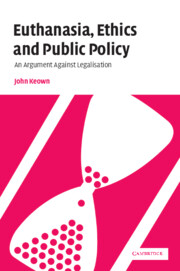Book contents
- Frontmatter
- Contents
- Preface
- Foreword
- Acknowledgments
- Table of cases
- List of abbreviations
- Introduction
- PART I Definitions
- PART II The ethical debate: human life, autonomy, legal hypocrisy, and the slippery slope
- PART III The Dutch experience: controlling VAE? condoning NVAE?
- PART IV Australia and the United States
- PART V Expert opinion
- PART VI Passive euthanasia: withholding/withdrawing treatment and tube-feeding with intent to kill
- Conclusions
- Afterword
- Bibliography
- Index
PART V - Expert opinion
Published online by Cambridge University Press: 20 July 2009
- Frontmatter
- Contents
- Preface
- Foreword
- Acknowledgments
- Table of cases
- List of abbreviations
- Introduction
- PART I Definitions
- PART II The ethical debate: human life, autonomy, legal hypocrisy, and the slippery slope
- PART III The Dutch experience: controlling VAE? condoning NVAE?
- PART IV Australia and the United States
- PART V Expert opinion
- PART VI Passive euthanasia: withholding/withdrawing treatment and tube-feeding with intent to kill
- Conclusions
- Afterword
- Bibliography
- Index
Summary
The question whether the law against VAE and PAS should be relaxed has been considered by expert committees, superior courts and medical associations around the globe. Their conclusions have typically been reached after exhaustive consideration of the arguments and evidence. Fortifying the conclusions reached hitherto in this book, these bodies have concluded almost without exception that the legal prohibition should be retained. A vital factor in their reasoning has been the dangers of abuse. This section will outline developments in three jurisdictions: England, Canada and the USA. Chapter 16 will consider the reports of expert committees; chapter 17 the views of the highest national courts, and chapter 18 the positions of the national medical associations.
- Type
- Chapter
- Information
- Euthanasia, Ethics and Public PolicyAn Argument Against Legalisation, pp. 181 - 182Publisher: Cambridge University PressPrint publication year: 2002

